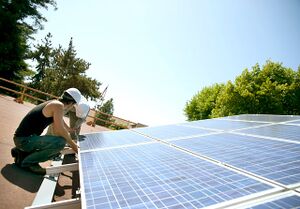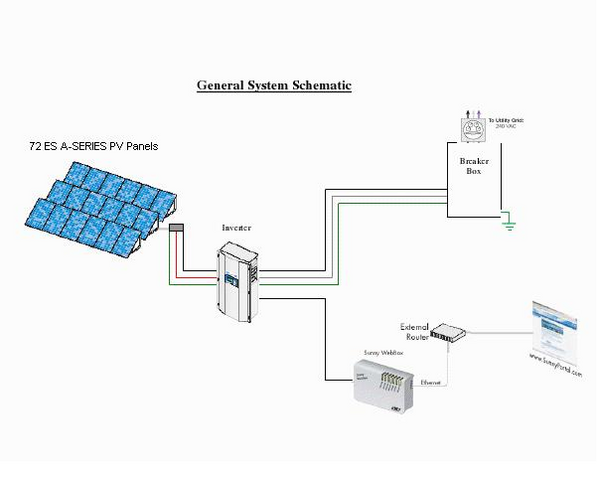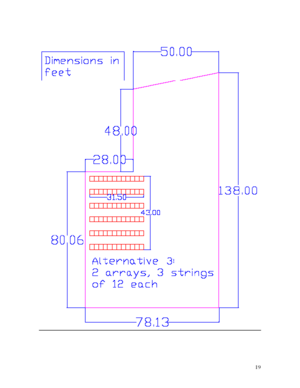
The purpose of this page is to describe the photovoltaic system on Music Building A at Cal Poly Humboldt(HSU), which harnesses a renewable source of energy to generate electricity on campus; this project is sponsored by the Humboldt Energy Independence Fund(HEIF), an entirely student-funded organization.
Project Purpose[edit | edit source]
The Old Music Building Photovoltaic Project was one of the first projects of HEIF,[2] the Cal Poly Humboldt Energy Independence Fund. HEIF members Kristen Radecsky, Peter Johnstone, James Robinson, and Nathan Chase proposed the project with the primary purpose of the PV system being the generation of enough electricity to power the music building through a renewable energy source. The PV project offers fiscal benefits for HSU by providing an expected 365,000 kW*hr over its lifetime, which otherwise would have to be purchased from Pacific Gas & Electric. The generation of electricity in this fashion reduces overall emissions resulting from campus energy demand. The production of electricity through solar panels reduces demand on fossil-fueled energy producers; HEIF calculates that 214 tonnes of CO2 emissions will be prevented.[3]
The secondary purpose of the music building's PV system is education through installation and interpretation. The project provides educational experience to students through hands-on training and practice in the installation and operation of photovoltaic technology. The project's interpretation phase, which has yet to be completed, involves the creation and display of a mural on the backs of the music building's solar panels that will enhance the educational impact of the project by bringing attention to the panels and invoke student interpretation of photovoltaic systems. The project is meant to be educational not only to the students directly involved, but to all students by conveying and advocating the concept of sustainable energy.[3]
Funding & Expense[edit | edit source]
The entire project was funded by HEIF, the Humboldt Energy Independence Fund. Funds are collected through HSU Associated Students' Instructional Related Activities Fee which contributes $10 per student per semester to HEIF. The HEIF committee was confident that the project successfully embodied HEIF's five goals, and that its fiscal, educational, and environmental benefits would outweigh the costs. Dr. Arne Jacobson, Associate Professor in HSU's ERE department, supported the HEIF project as an adviser during grant administration by RESU (Renewable Energy Student Union) and the proposal was approved in April 2007.[2]
| Solar Panel Expense | Expected Electrical Output Over Lifetime | Total Cost Per Unit |
|---|---|---|
| Capital Investment--$95,943.00 | Warranty on Panels--25 years | Total Lifetime Costs--$124,697.00 |
| Projected Future Costs--$28,754.00 | Estimated Average Daily Output--40kW*hr | Total Lifetime Output--365,000kW*hr |
| Total--$124,697.00 | Total Output Under Warranty--365,000kW*hr | Cost Per Kilowatt Hour--$.34kW*hr |
In the music building PV system project proposal, there were three different sized systems proposed: a 3.5 KW, a 5.3 KW, and a 10.5 KW system. The largest system was chosen (10.5 KW), and accounting for all of the components of the system, installation and equipment, wages for labor, interpretive art materials and installation, and taxing and shipping costs, the requested initial cost of the project was $95,943. This figure does not account for the additional $28,754 in projected future costs for continuing maintenance and equipment replacement on the system. The energy cost per unit from the initial cost is $.34 per kW*hr,[2] presented in Table 1 with a summary of costs and potential energy production. The system's estimated energy generation over twenty-five years (25 year warranty on panels) is valued at $62,000. As of 12/11/2009, there is no available data regarding either building energy demand or actual electrical generation.
Importance of Location[edit | edit source]
Location is paramount when planning the installation of a PV System, the efficiency of solar panels varies significantly among different settings and solar panels out of sight do not promote attention. The music building showed to be the most logical choice and was the only building suggested in the final proposal for the following reasons:
- The music building's roof is completely flat, allowing safe installation for contractors and student interns.
- A "Solar Pathfinder" was used to calculate the solar window of the music building, and it showed the building offered maximum sun exposure and little shading from other buildings or trees.
- Music Building A has great visibility being centrally located on the HSU campus. All students are able to see the efforts of construction, beautification, and maintenance, connecting more students to the project and strengthening HEIF's public outreach efforts by raising awareness.
The only hesitation in deciding to build the PV system on top of the music building was because the music building was constructed to be a "temporary" building. However, the building has been standing for over 45 years, there have been no plans for demolition and will not be for at least a decade. So the music building was chosen for the site of the project and stands there today. If something does happen to the "temporary" building in the future, all components of the system are designed to be relocated to a different site on campus.[3]
Components[edit | edit source]
The 10.5 KW photovoltaic system is composed of 72 solar panels, an inverter, a breaker box, and an output monitoring system. Figure 2, below, depicts these components schematically.[2]

Solar Panels[edit | edit source]
The 72 Evergreen Solar A-Series Photovoltaic Panels are aligned in six rows of twelve. The panels are mounted on Unirac tilted racks on the music building's roof. These panels generate electricity in the form of Direct Current. This current is transported via cable to the inverter.
Inverter[edit | edit source]
The Sunny Boy inverter converts the direct current produced by the panels into Alternating Current. The process of converting DC power to AC is required in order to use to electricity within the music building's electrical system.
Breaker Box[edit | edit source]
The AC current travels to a breaker box where it ties into the music building's electrical system. Tying the photovoltaic system into the buildings electrical system enables produced electricity to be utilized by the building, as well as creating a pathway to the grid. If the generated electricity is greater than the old music building's electrical demand, the excess electricity is provided to the campus-wide grid and is utilized elsewhere within the university.
Web Box[edit | edit source]
The system is hooked up to a SMA Sunny Portal Web Box which displays the amount of energy being generated by the system at a certain time. In the future, the Web Box will be programmed to an external router which puts the past and present data from the PV system on the internet www.SunnyPortal.com.
All components are able to be relocated if the system needs to be moved to a different building in the future.[2]
Implementation[edit | edit source]

Construction & Installation[edit | edit source]
After the project proposal was accepted in April 2008, construction occurred over the summer of 2009 and was completed in August. The installation phase of the project was overseen by Plant Operations at HSU. Plant Operations hired a contractor, Scurfield Solar, who acted as a teacher for the hired student interns who also helped with installation.[2]
After the contractors and interns were selected, the materials were ordered, moved on-site, constructed and wired according to the aerial view of the system's layout illustrated in Figure 3. As of August 15, 2009, the system has been up and running; the installation phase is complete and now the interpretation phase is ready to begin.[3]
Obstacles[edit | edit source]
Installation did encounter a few obstacles, but the project was able to be completed successfully. There were apprehensions about paper contracts with student interns and allocation of responsibility, but the situation was resolved so that the contractors and student interns were able to work together effectively, and the students were able to get real hands-on instruction and experience through the project.[3]
The project is located on a building where people learn music, but it is not practical to have loud construction going on when musical instruction is taking place. Construction time had to be scheduled according to instruction time.
Minor roof modifications were required to support the panels as well as the electrical wiring. There were also complications with wiring the PV panels to the building. The old electrical panel for the music building needed an updated breaker because the circuit breaker within the building must be manufactured by the same company as those who produce the panels. The contractors were required to install a new, updated circuit breaker.[3]
Interpretative Education[edit | edit source]
The PV system atop the music building is designed for awareness and education, as well as functionality. The implementation of the PV system in the center of campus, as well as a digital monitoring meter, mounted on the side of the building allow the campus community to view the applications and functionality of small-scale photovoltaic systems. HEIF also allocated funds for the incorporation of a mural on the backs of the solar panels. This project has yet to begin but will be completed by students in the HSU art department. Artists have yet to be organized for the project, although the project most likely will not occur until the warm, low precipitation months of summer.
Related projects[edit | edit source]
References[edit | edit source]
- ↑ Student Project Adds Green Energy to Campus - Humboldt State Now. (2009, August 21). Humboldt State Now. Retrieved October 29, 2009, from http://now.humboldt.edu/news/student-project-adds-green-energy-to-campus/
- ↑ 2.0 2.1 2.2 2.3 2.4 2.5 2.6 2.7 Radecsky, K., Johnstone, P., Robinson, J., & Chase, N. (Spring 2008). Old Music Building Photovoltaic Project. Humboldt Energy Independence Fund. Retrieved October 13, 2009, from http://web.archive.org/web/20100605013159/http://www.humboldt.edu/%7Eheif/proposals/RESU_pv_old_music_spring_08.pdf
- ↑ 3.0 3.1 3.2 3.3 3.4 3.5 Comet, Tall Chief. Cal Poly Humboldt Campus Sustainability Coordinator. (Personal Communication, 21 October 2009).